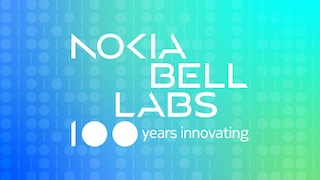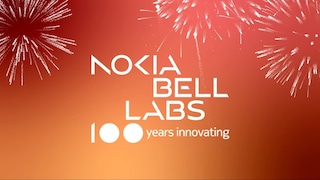Nokia Bell Labs celebrates 100 years
of innovation and looks ahead to
another century of discovery
6 February 2025

When AT&T and Western Electric officially created Bell Telephone Laboratories in 1925, the world was on the cusp of a technological revolution.
There were no televisions, transistors or transoceanic telephone cables. There were no communications satellites, cellular networks or high-speed fiber optics. No movies with dialogue, digital cameras or advanced radar systems. No lasers, solar cells or computer software.
Over the next century, Bell Labs would prove pivotal in establishing them all along with dozens of other groundbreaking discoveries and innovations that have spawned the digital age and revolutionized the world.
The research institute established the foundations of modern communications, computing and the internet, and made world-altering breakthroughs in radio astronomy, information theory and cellular connectivity.
But Bell Labs has not just set the standard for the telecommunications industry and defined technological trends. Powered by bold imagination, it has reshaped modern life. Wherever one goes, wherever one is, everyone is carrying a bit of Bell Labs history in their pocket. The name itself has become synonymous with invention and ingenuity, and its myriad achievements include 10 Nobel Prizes and five Turing Awards, as well as three Emmys, two Grammys and an Academy Award.
That legacy lives on today in wavelengths, wires and bits, as Nokia’s global industrial research lab continues to penetrate every corner of human existence and charts new paths in space communications, quantum, artificial intelligence, foundational technologies and sensing that address humanity’s most pressing challenges.
Its pioneering technologies propel society, industry and the environment toward a more sustainable future — expanding possibilities and redefining the way people live, work and care for the planet – and setting the stage for the next century of discovery, disruptive innovation and real-world impact.
Pioneering progress from the transistor to the digital age
It all began with the telephone. Bell Telephone Laboratories was established on Jan. 1, 1925, in New York City, as a semi-autonomous entity dedicated to research and development. Under the vision of its first president, Frank Jewitt, it created a new, focused approach to innovation.
Fitting for a company that owes its name to Alexander Graham Bell, the earliest Bell Labs innovations revolved around providing clear, reliable telephone connections. Bell Labs' early years were marked by a relentless pursuit of innovation in the fields of speech and sound.
As such, the 1920s and 1930s included inventions such as the Artificial Larynx, Long Distance Television Transmission and Synchronized Sound Movies.
But it was the 1947 invention of the transistor that changed everything. This tiny semiconductor device was capable of amplifying and switching electronic signals, revolutionizing electronics. This groundbreaking discovery laid the foundation for the modern computer age.
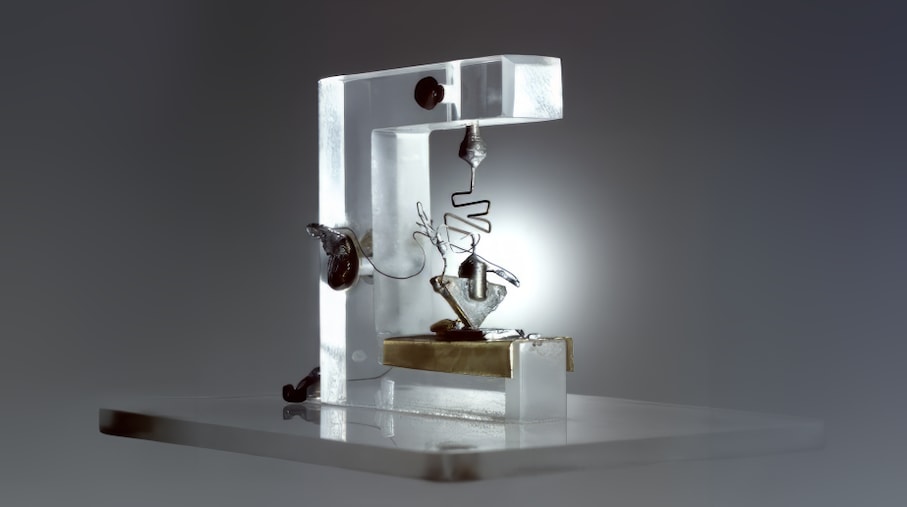
The point-contact transistor
The following year, Claude Shannon introduced Information Theory, turning our world into bits and bytes of 0s and 1s. These principles established the foundation for modern communications, computing, digital media, compression, cryptography and the internet.
Shannon’s creation of "Theseus," a mechanical mouse controlled by an electromechanical relay circuit that enabled it to move around a labyrinth of 25 squares, was one of the first applications of artificial intelligence. In 1955, he co-authored the paper that formalized AI as a field of study at the inaugural Dartmouth conference the following year.
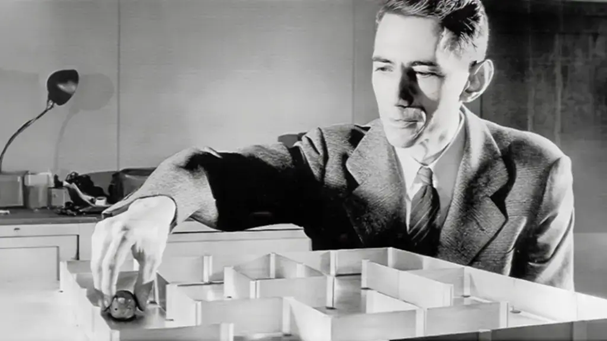
Claude Shannon and Theseus, a robotic maze-solving mouse
The 1960s saw Bell Labs at the forefront of the digital revolution. The development of the Unix operating system, the C programming language, the charge-coupled device and the first commercial cellular network paved the way for the interconnected world we know today. The invention of the laser, a revolutionary light source with countless applications, further cemented Bell Labs' reputation as a powerhouse of scientific discovery.
Shaping global communication
Bell Labs' impact extends far beyond the confines of its research facilities – even the confines of Earth itself. From the development of the first satellite communication system to the invention of the digital signal processor, Bell Labs has consistently pushed the boundaries of communication technology. It has connected the globe with telephone lines, fiber optic cables and cellular signals.
And Bell Labs didn’t limit itself to our planet. It has a long legacy in space, working with NASA on the Mercury, Gemini and Apollo missions.
The 1962 launch of Telstar 1 was the first orbiting communications satellite to transmit TV signals. Suddenly, breaking news, sporting events and video communications could be broadcast live to distant parts of the globe thanks to that seminal satellite.
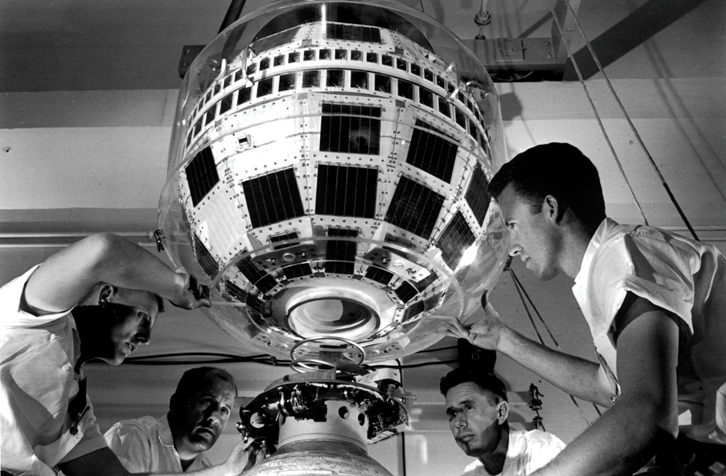
Telstar 1
Two years later, a pair of Bell Labs researchers discovered cosmic microwave background radiation, which became one of the strongest pieces of evidence to support the “Big Bang” theory of the explosive origin of the universe.
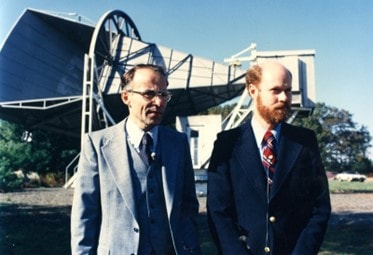
"Big Bang" discoverers Arno Penzias (left) and Robert Wilson in front of the Holmdel Horn Antenna
Today, Nokia Bell Labs is deploying the first cellular network on the Moon as it seeks to prove that cellular technologies can meet extraterrestrial communications needs.
When NASA’s Artemis III crew lands on the Moon as early as mid-2027, they will use next-generation spacesuits from Axiom Space that Nokia Bell Labs equipped with integrated network connectivity. This advanced lunar surface network allows astronauts to communicate with each other and capture real-time video, biometric and telemetry data and communicate with Mission Control on Earth. These communications solutions will also support scientific exploration, such as the search for lunar water, which astronauts could convert to breathable oxygen and use to create fuel for future space missions.
“Our legacy is built on 100 years of bold imagination and innovative breakthroughs that have changed how we connect people and communities worldwide,” said Dr. Thierry E. Klein, President of Bell Labs Solutions Research at Nokia. “Now, thanks to our visionary technologies, we are delivering the communication building blocks here on Earth as well as for the rapidly growing space economy that underpins sustained human presence on the Moon and eventually on Mars.”
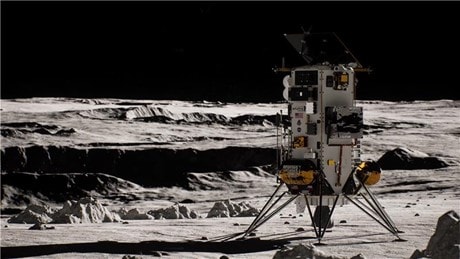
A rendering of the Intuitive Machines Athena lander
A legacy of innovation in solving real-world challenges
Today, Nokia Bell Labs continues to push the boundaries of scientific discovery and applied research. The company is actively exploring the frontiers of AI, quantum computing and 6G wireless technologies. With a focus on creating a more sustainable and connected future, Nokia Bell Labs is dedicated to addressing global challenges through technological innovation.
It is setting world-record optical speeds to meet the insatiable global demand for high-speed communication. It has launched UNEXT, a new research initiative that creates a unified networking experience for autonomous service creation. It is advancing Web3 and unlocking the potential of a future hyper digital-physical world by laying the foundations with 6G networks.
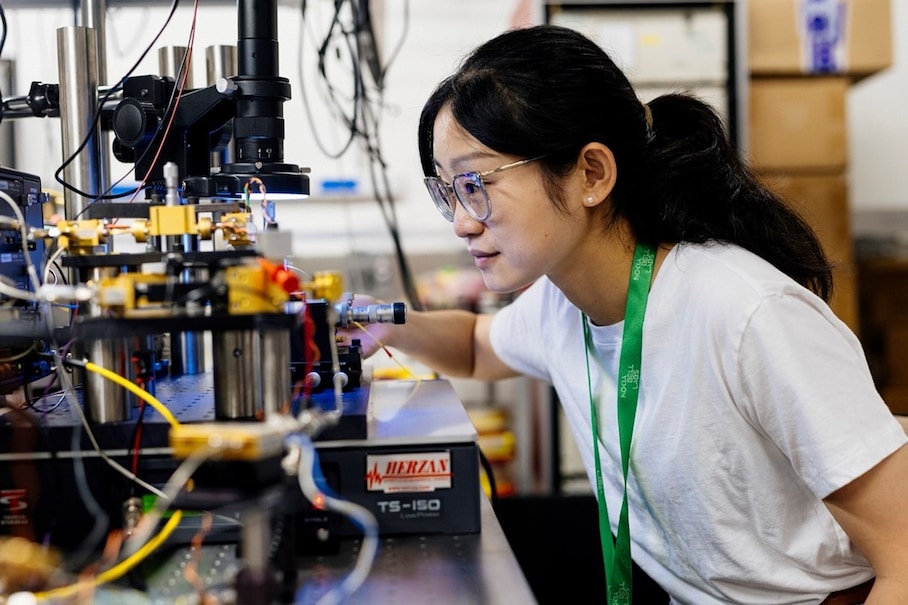
A Nokia Bell Labs optical researcher working in the lab
Its groundbreaking work in artificial intelligence and dynamic digital twins is powering the upcoming Industry 5.0 and investigating quantum technologies to radically transform industries and reshape how we live. And it is inventing technologies that create a sixth digital sense for humans, industry and networks. This includes wearable sensors for non-invasive health monitoring, sensors that can model new drugs and proteins, environmental fiber sensing on the ocean floor to improve earthquake and tsunami monitoring and 6G sensing that provides real-time insights into the location of robots, machines and people in industrial environments to improve safety.
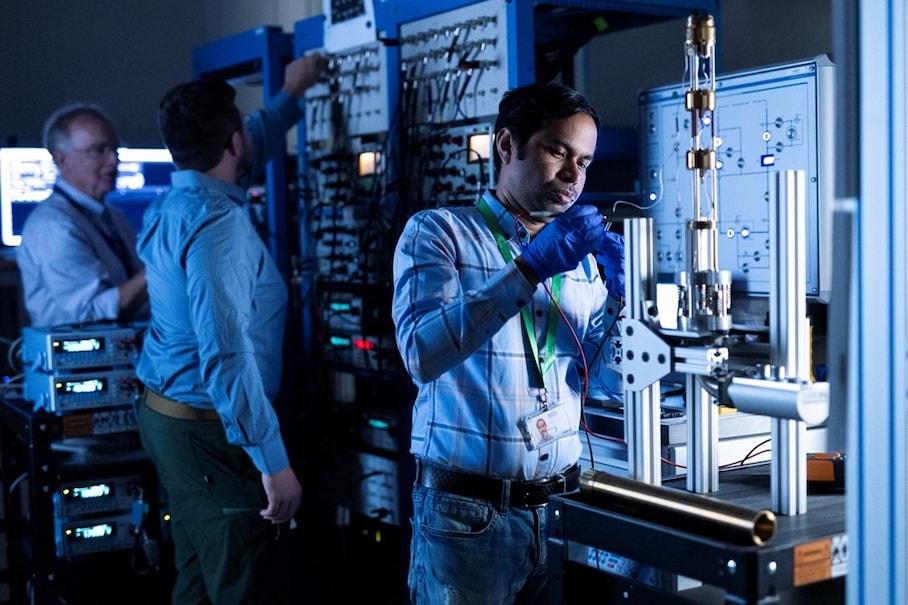
Nokia Bell Labs quantum researchers working in the lab
“We don't just follow the trends that redefine what's possible. We create them. We design the foundational innovations that transform how we interact with the world, and Nokia builds them,” said Dr. Peter Vetter, President of Bell Labs Core Research at Nokia. “Together, we are redefining how we understand the world around us by powering technologies that can sense and understand our environments and the people and objects within them.”
Expanding possibilities into the next century
The Nokia Bell Labs Centennial offers a moment to reflect upon the profound impact this institution has had on the world. From the transistor to the internet, Nokia Bell Labs has been at the forefront of technological advancement, shaping the future of communication and innovation. Looking ahead, it is poised to continue playing a vital role in shaping the world of tomorrow.
The story of Nokia Bell Labs is a testament to the power of human ingenuity and the transformative potential of scientific discovery. It serves as a source of inspiration for generations to come that dedication, collaboration and a relentless pursuit of knowledge can lead to remarkable things.
“As Nokia Bell Labs enters its second century, the world faces new challenges and opportunities. It’s impossible to imagine the past 100 years without Nokia Bell Labs, and it’s difficult to imagine the next 100 years without it either,” said Nishant Batra, Nokia Chief Strategy and Technology Officer. “Our commitment to innovation, coupled with our rich history of groundbreaking discoveries, allows us to shape a brighter future for all, as we continue our journey of imagination to innovation to impact. Our legacy is in every bit within the billions and billions of terabytes that traverse global networks each year. And we are just getting started.”
Read more
About Nokia
At Nokia, we create technology that helps the world act together.
As a B2B technology innovation leader, we are pioneering networks that sense, think and act by leveraging our work across mobile, fixed and cloud networks. In addition, we create value with intellectual property and long-term research, led by the award-winning Nokia Bell Labs.
With truly open architectures that seamlessly integrate into any ecosystem, our high-performance networks create new opportunities for monetization and scale. Service providers, enterprises and partners worldwide trust Nokia to deliver secure, reliable and sustainable networks today – and work with us to create the digital services and applications of the future.
Media inquiries
Email: Press.Services@nokia.com
Nokia Communications, Corporate
Follow us on social media
LinkedIn Instagram Facebook YouTube

